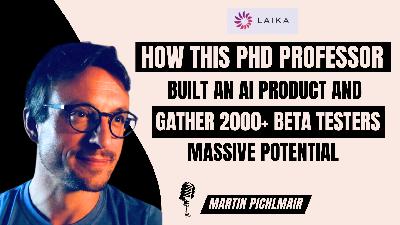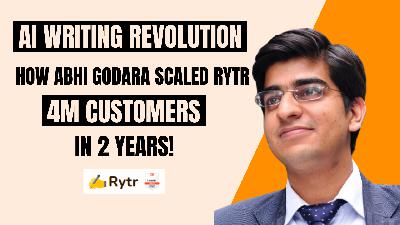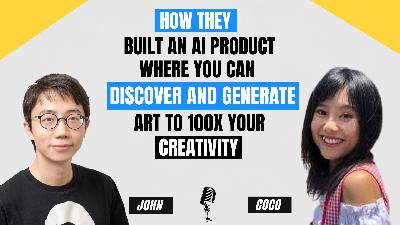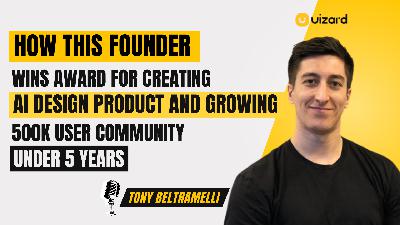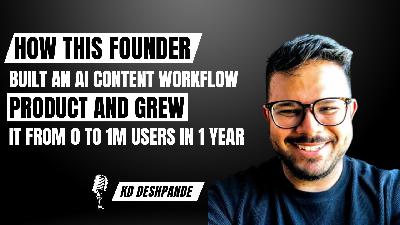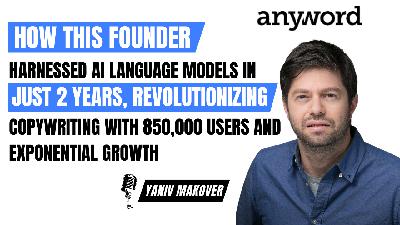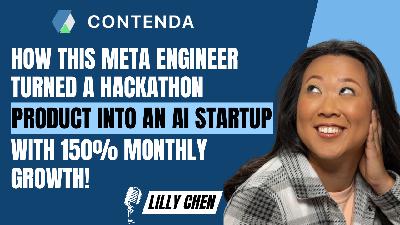This founder built an AI product to help you become a super-learner.
Description
Calin Drimbau is the Co-Founder & CEO at Broadn. Broadn is personalized learning through Generative AI. In today's episode, Calin shares how he came up with the idea and how the product works, including the three layers of abstraction and the pipeline of information that flow through the product. Calin also shares insights on his financial journey and the challenges of integrating audiobooks into their data processing. Aspiring AI product creators will learn valuable lessons on how to approach AI product development and accelerate growth towards their vision of personalized learning.
Find the full transcript at: https://www.aiproductcreators.com/
Where to find Calin Drimbau:
• LinkedIn: https://www.linkedin.com/in/calindrimbau/
Where to find Dhaval:
• LinkedIn: https://www.linkedin.com/in/dhavalbhatt
In this episode, we cover:
00:00:00 - Introduction
00:01:02 - Overview of Broadn's product journey
00:02:26 - Finding the kernel of the idea and launching the product
00:05:05 - User journey and monetization plans
00:09:44 - Conceptual product architecture and data flow
00:13:30 - Building semantic search engine that feeds users valuable and summarized content
00:14:00 - Calin's background in product and his co-founder's deep expertise in machine learning
00:15:34 - Calin's financial journey and plans to raise capital for pre-seed round
00:17:58 - Challenges of integrating audiobooks into AI data processing due to copyright issues
00:19:52 - Quick experimentation and iteration using large language model APIs
00:19:52 - Importance of understanding customer problems before building AI products
Transcript:-
Dhaval:
This founder built a whole new category of ai, product known as generative learning to help you tailor your learning based on the individual context, learning goals, and learning style. Calin Drimbau the founder of Broadn. Shares how he built his AI product using. Three layers of abstraction and have, you can follow the same type of product architecture to solve your specific workflow using AI resources that he shares.
Welcome, Glenn. Tell us about yourself and your product.
Calin Drimbau:
Hi, pleasure to be here. I'm Calin. I'm the founder of Broadn. We're building a new solution for learning. It's personalized learning at its best. in many ways we're defining a new category and that is generative learning. We're using generative models to be able to tailor learning based on the individual context, learning goals, and learning style. Of users. we're very excited to be building in this space and it's a pleasure to be here and have this conversation with you.
Dhaval:
Wow, that's like personalized learning at scale. Tell us a little bit about where you are in your product journey. Has it launched? Is it, being billed? Is it in beta? Is it still being developed?
Calin Drimbau:
Sure. So we've been on this journey for about a year now, and we've launched a couple of products., the first product that we launched was a product that was doing classification on, podcast content. So we would be listening and, transcribing the text from audio and then identifying topics that are being discussed in conversation and using AI and then clipping creating automatic clippings and placing all of these into a platform for learning which was in a form of a mobile app. So that was our first product, and moving away from that, in conversations with , our users, we've learned that what they wanted to do more above and beyond getting the best clips from podcasts. They wanted to navigate and explore this content by searching. so a big problem for people in the audio space is, identifying the most valuable parts of a conversation. , and they wanted to do that by search. so our newest product that we've recently launched is, A semantic search engine on top of podcast content. and happy to speak more about that. We've launched that last week on Product hunt.
Dhaval:
Wow. Yeah. Tell us a little more about how did you find , the kernel of the idea and, how is it doing now that you've launched it? How is it received by the audience.
Calin Drimbau:
Sure. So I'm a big podcast listener, and I'm a big consumer of knowledge, if you want from books, articles, YouTube. I consume a lot of information and my personal problem was that especially with audio and video content, it's not easy to navigate, this content. It's usual. It's usually presented in a linear format. So oftentimes , when I'm looking. To consume content is because I'm trying to solve a problem or it's been, it's because I'm trying to learn more about a mental model. So having had experience building machine learning products on text, I thought, why doesn't anyone do? Processing and parsing of podcast transcripts to identify and classify what's being discussed. So that was the genesis of the idea. Beyond that, I suppose once we've launched it , in the market as I've said previously, users wanted more flexibility on how they consume this knowledge the app itself was very useful in terms of like saving a lot of time and instead of having to listen to one hour or two hour podcast, they'd be able to listen to 10 clips on the specific topics that they wanted to learn more about. A lot of the content on the platform is learning content, like entrepreneurship or product or any type of lessons and clips from , podcast surfacing and talking about these topics. But then one of the constant requests that we're getting from users is I wanna have more power in my hands to be able to navigate this content. So if we take Lenny Rachitsky's content, for example which I'm a big listener, of content too, they asked for an ability to search for specific topics or episodes or experts so that instead of listening to, the two hour episode, they'd be able to zoom in and double click on exactly the specific lesson that, that the author or the guest is, highlighting in, in that episode. So that's why we built the search interface on top of podcast content. And we've actually built it. Just on top of Lenny's content as a first drop, obviously the same technology can be deployed and adapted to surface semantic search on any podcast content. And this is one of the things that we are, we're exploring but, podcast content and searching, or semantic search, if you want, is just in our view, the first or the stepping stone in term in terms of realizing our, our vision for personalized learning.
Dhaval:
Wow. Yeah. I would love to get into the nitty-gritty of how you build the product. We'll get into that in a second. But first I wanted to dive into the user journey. So you have two-sided market. One is the listeners and the other are the creators. Are there any other sides to your market? How do you monetize this product? Is it subscription based product? Is it advertising? Yeah. Tell us a little bit about any other sides of the market you may have, and more importantly, I'm curious about is this like a one central place where the end consumers go to search for podcast clips? Or is it a service you provide to podcast creators who want to put this interface on top of their podcast so that people can consume it more effectively?
Calin Drimbau:
Yeah, good question. Obviously these are things and ideas that we've been exploring for a while now, whether we pivot into one side, a two-sided marketplace, or a one-sided marketplace for , for creators. was the questions that we've, a question that we've asked ourselves At the moment. Our vision is to create a consumer platform, not a typical marketplace if you want, because we're taking all the public content that is exists out there. So everything that a creator has deployed and it's not just audio. We started with audio and we started with podcast. But we're able to process video, YouTube and we're able to process essays and any type of blog published by, by authors and creators. in terms of the, monetization, cuz you've touched on that, the big goal is for all of these mini products that we're building and validating at the moment to form. A bigger consumer product that will have a multiple set of use cases. So indeed one of the first use cases that the product will feature is the search, or semantic search, throughout a set of podcasts. But above and beyond that, the additional use cases that we're currently working on building in, into the platform are the ability for a user to define and set their learning goals. , and, the platform, it would be able to know and understand the context of the user, and it'll generate, if you want , a dynamic personalized course. For the user. Now, the way it does that is, is a little bit dissimilar to, a typical interaction with something like chatGPT where. You'd be able to prompt the interface and ask for content. And a large language model will process that request and give back some answers to you. We're doing it slightly differently in the sense that, we have micro verse of content that we are pre-selecting, and on top of which we deploy semantic search. So this is why the semantic search, is very important because within the universe of content that is created by. We're first running semantic search, and then we're deploying, summarizat




